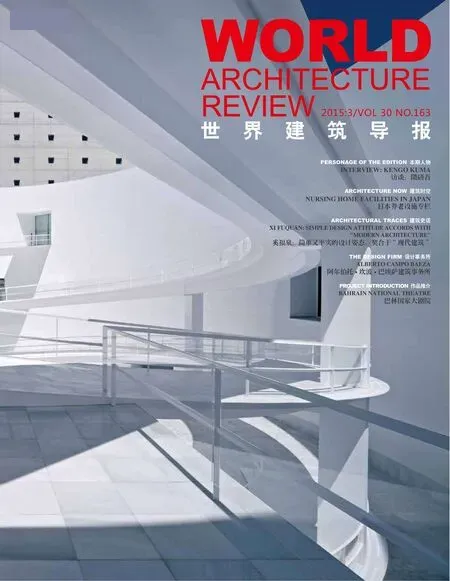访谈:隈研吾
(图片)根津美术馆
(摄影)FUJITSUKA Mitsumasa
访谈:隈研吾
(图片)根津美术馆
(摄影)FUJITSUKA Mitsumasa
INTERVIEW: Kengo Kuma
导报:您能否以马头町广重美术馆为例,介绍一下您设计当中的核心价值观?
隈研吾:我的核心价值观是以地理位置为重。
导报:您设计了许多的博物馆,它们有没有什么共同的关键元素?
隈研吾:要记得,内容(即艺术作品)在建筑物中扮演着核心角色。 简单地说,建筑应该支持内容,内容才是最重要的。
导报:在博物馆设计中,您通常采用什么方法来处理人与建筑空间之间的关系?
隈研吾:理清人流的顺序。 他们如何走进博物馆? 进入博物馆之前,他们可能走了什么路线? 另外,对于博物馆里的工作人员,这里也应该是个快乐的地方。
导报:请描述一下您的设计方法和过程是怎样的?
隈研吾:首先必须考虑建筑材料。形式并非首先考虑的因素。
导报:能否请您谈谈您自身从开始进入设计至今的演变过程吗?
隈研吾:我倾向于认为,我是在不断发展进步的。这是一个很自然的过程。人会成长,会认识新的人和新的环境。与刚开始担任建筑师那时候相比,我现在是截然不同的一个人。
由于教育模式对创造性思维的抹杀、传统思维习惯的制约、动画人对动画艺术理解的狭隘、动画片受众定位的低龄化和国外加工行业的薪资诱惑等原因,导致目前中国动画剧本存在的最大问题是缺乏创意。中国动画要想打开国内市场,走进国际市场,拥有既传统又现代、既本土化又全球化的特色,首先要给予重视的就是找寻动画剧本的创意。
导报:您认为在建筑实践方面,西方国家、日本和中国之间有什么典型的差异呢?
隈研吾:差异仅存在于个人之间,并不存在于国家之间。因此我无法一概而论。 无论项目在哪里进行,我都接受并尝试欣赏差异。
导报:日本建筑师之间的文化传承是显而易见的。从老一辈的黑川纪章、安藤忠雄到隈研吾、妹岛和世,再到新一代的藤本壮介,这些建筑师都获得了世界认可。这其中的关键因素是什么呢?
隈研吾:日本的气候?日本有着美丽的自然环境,但也有自然灾害,并且由于多山地貌,适宜居住的地区是很有限的。所以,人们需要培养一定的智慧,才能为自己创造空间。
导报:日本的很多建筑都很精致,能否大致介绍一下日本建筑业的模式呢?
隈研吾:在很长一段时间里,白色、表面光滑的建筑风格十分盛行。但3.11日本东部大地震改变了这一切。我们回归到更自然的土色建筑——不仅在物质上,而且在理念上。



WAR:Can you give a detail description of your core values of design ? For example Nakagawa-machi Bato Hiroshige Museum of Art.
Kengo Kuma:My core value is to pay respect to the location.
Kengo Kuma:To keep in mind that the content (the art works) plays the central role of the building. Architecture should simply support the content, which matters most.
WAR:What way do you take in terms of dealing with the relationship between people and architectural space in Museum design?
Kengo Kuma:To provide sequences between people. How should they walk in to the space? What kind of paths might have they taken before coming into the museum? And it should be a happy place for people working in the museum, too.
WAR:How would you describe your design approach and process generally?
Kengo Kuma:Consider materials for the building. Before anything else. It is not a form that should come first.
WAR:Can you describe an evolution in your design from the very beginning till now?
Kengo Kuma:I would like to believe that I evolve all the time. It is natural to be like that. You grow, you get to know new people and environments. I am completely different from myself when I began to work as an architect.
WAR:In your opinion, what are the differences between western countries, Japan and China in terms of the architectural practice?
Kengo Kuma:Differences exist only between individuals. Not between countries. So I cannot generalize. I accept and try to enjoy differences wherever the project takes place.
WAR:The Inheritance of Japanese architects is very obvious. From the older generation kurokawa kiso, Andou tadao, to Kengo Kuma, Kazuyo Sejima, following the young generation Sou fujimoto, received approval in the world, what is the key factor among these?
Kengo Kuma:The climate of Japan? Beautiful nature, but not free from disasters, and habitable area is limited as the land is so mountainous. People needed to have nurtured wisdom to create spaces for themselves.
WAR:Many of the architectures in Japan are delicate, can you make a general introduction about the mode of the architectural industry in Japan?
Kengo Kuma:For a while, white, smooth-faced structures was dominant in style. But 3.11 East Japan Earthquake converted it. We are coming back to more natural, earth-colored architecture – not only in substance, but in ideas, too.



